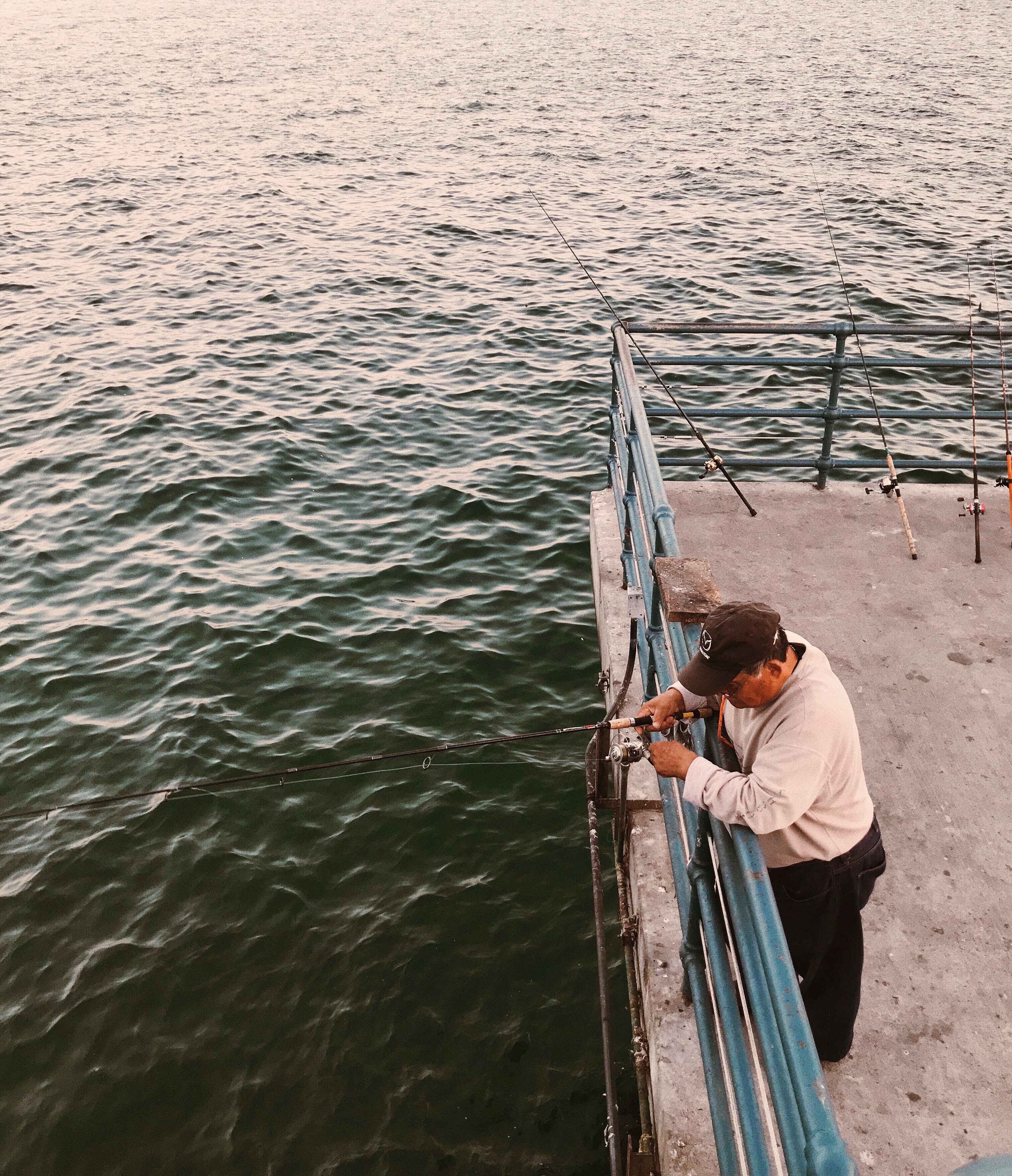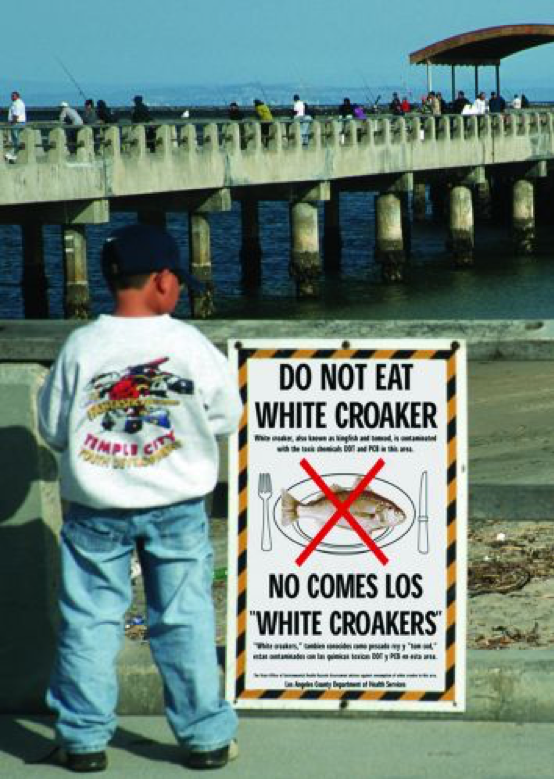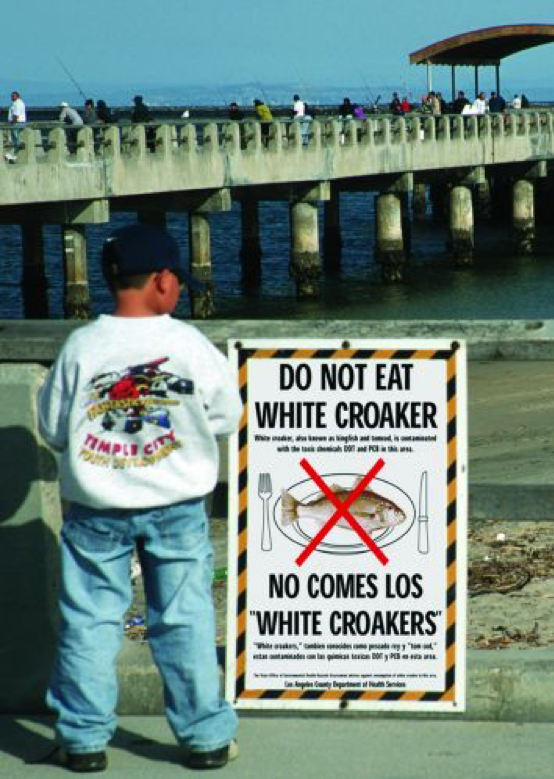Income and ethnicity have shown to be accurate quality-of-life predictors in urban areas throughout the country. Generally, low income and communities comprised of Black people, Indigenous people, and people of color (BIPOC) are more significantly impacted by issues involving water sanitation, air quality, childhood obesity, education, and many others. These inequities are not standalone problems and are closely intertwined with other aspects that perpetuate the cycle of poverty.
For my California Sea Grant fellowship, I am working with the Office of Information Management and Analysis (OIMA) at the State Water Resources Control Board (SWRCB). When I am not memorizing countless acronyms, I analyze data and collaborate with other agencies to characterize safe levels of fish and shellfish consumption. Catching local fish provides a cheap source of protein and a major part of diets for lower income communities. While generally healthy, fish can contain contaminants like mercury, which in certain concentrations can harm humans and affect child development. From both ecological and public health perspectives, it is critical to analyze how contaminants can bioaccumulate in people who eat local fish, particularly if they are relying on them as a significant food source.
To better understand how different demographics catch fish, eat them, and are impacted by contaminants, I analyzed studies and angler surveys from San Diego Bay (SD Bay), San Francisco Bay (SF Bay), and Central Valley waterbodies, as well as fish consumption advisories from the California Office of Environmental Health Hazard Assessment (OEHHA).
Subsistence angler demographics
 In California, anglers over the age of 16 are required to purchase a yearly $50 fishing license from the California Department of Fish and Wildlife (CDFW) in order to take fish, crustaceans, or mollusks. However, an important exception is that a fishing license is not required when fishing from piers or jetties. As such, anglers who want to avoid purchasing a license or being cited by the CDFW choose to fish from piers and make up the largest groups of anglers represented in the surveys. Based on 2015 Census tracts, almost all pier anglers reported under the 200% poverty level, defined as a household of four with a total annual income of less than $50,000, with many under the 100% poverty level (less than $25,000).
In California, anglers over the age of 16 are required to purchase a yearly $50 fishing license from the California Department of Fish and Wildlife (CDFW) in order to take fish, crustaceans, or mollusks. However, an important exception is that a fishing license is not required when fishing from piers or jetties. As such, anglers who want to avoid purchasing a license or being cited by the CDFW choose to fish from piers and make up the largest groups of anglers represented in the surveys. Based on 2015 Census tracts, almost all pier anglers reported under the 200% poverty level, defined as a household of four with a total annual income of less than $50,000, with many under the 100% poverty level (less than $25,000).
Only about 10% of pier and shore-based anglers had a college degree, and many never even finished high school. By comparison, 50-75% of private and charter boat-based anglers were college educated and had an annual income greater than $50,000 per year. Pier anglers were predominantly Asian, with Hispanic and Black anglers present in lower yet substantial proportions. White anglers were the smallest demographic of pier anglers and the largest demographic of boat-based anglers.
Fish consumption patterns
Pier anglers were found to consume more of their catch than private boat, charter boat, and other shoreline anglers combined. While the SF Bay survey indicated that fish-catch consumption did not significantly vary based on income, the SD Bay survey showed that consumption was high among poorer anglers and declined considerably as income increased. The more times an angler fished per week, the higher their consumption rate.
Based on these various characterizations, the majority of pier anglers generally are people of color without a college degree from low income communities who often eat what they catch. Locally caught fish as the primary protein in a diet is inexpensive but has other costs—higher levels of fish consumption means higher levels of mercury uptake. However, the quantity of fish consumed isn’t the only problem—the quality matters as well.
Species-specific advisories
 White croaker, a marine fish with historically high contaminant levels, are four times more likely to be consumed by pier anglers than boat-based anglers. An occasional serving would have negligible health impacts, but consistent consumption of such fish is certainly above advisory levels.
White croaker, a marine fish with historically high contaminant levels, are four times more likely to be consumed by pier anglers than boat-based anglers. An occasional serving would have negligible health impacts, but consistent consumption of such fish is certainly above advisory levels.
Pier anglers are limited to certain fishing locations, which can also influence their catch and contaminant intake. For example, OEHHA advisories for Pacific chubb mackerel (PCM) set limits of two weekly 8 ounce servings for “sensitive” consumers (children or women aged 18 – 49) and four weekly servings for “general” consumers—if the fish is caught in coastal ocean waters. In San Diego Bay, elevated contaminants and maritime activity lead to respective limits of zero and one servings, yet PCM are the most popular consumption fish in the bay.
This discrepancy is present in many popular fish landed by pier anglers, which often have higher contaminant levels than their coastal counterparts. Anglers who fish multiple times a week to feed their families likely surpass contaminant limits on a regular basis, particularly if they eat multiple species with advisories.
OEHHA’s regional fish advisories are available in multiple languages on their website and near some popular fishing spots and piers to inform anglers about contaminant levels. However, only half of all anglers surveyed were aware of such advisories. Anglers who identified as Asian were recorded to have the highest amount of fish consumption and scored lowest in awareness of the advisories.
Additional implications
While these statistics clearly indicate that poor, subsistence anglers are disproportionately consuming contaminants through fish, the actual impacts are even worse. Pier anglers bring their catch home to share with their likely “sensitive” spouses and children, further exceeding their already low advisory limits. Cooking methods reported by low income and Asian consumers typically retain the fish skin and cooking juices, both of which contain more contaminants than the skinless fillets OEHHA recommends. Some fish like pikeminnow, which are generally consumed only by low-income anglers, have strict advisories in some places, but no existing data in others. OEHHA’s algorithms for calculating consumption limits cannot account for data deficiencies, cooking styles, and people who consume far above thresholds out of necessity.
Pathways to improvement
 There are both legislative and locally-focused methods that can help reduce contaminant intake by disadvantaged communities. The passing of California Assembly Bill 762 requires regional health officers to post fish advisory signage near popular fishing locations, improving risk communication to all anglers statewide. While this is a broad measure, it could help identify underserved populations, guiding more directed efforts and coverage to areas with relatively high proportions of subsistence anglers.
There are both legislative and locally-focused methods that can help reduce contaminant intake by disadvantaged communities. The passing of California Assembly Bill 762 requires regional health officers to post fish advisory signage near popular fishing locations, improving risk communication to all anglers statewide. While this is a broad measure, it could help identify underserved populations, guiding more directed efforts and coverage to areas with relatively high proportions of subsistence anglers.
Multiple surveys indicated that community-based approaches are more likely to reach target audiences than just government agency actions alone. Health officers can connect with consumers about region-specific fish advisories, learn about popular data-deficient species, and encourage discussion while keeping cultural values in focus.
Contaminants like mercury are considered persistent—they remain in ecosystems for decades—so risk mitigation must be wide-reaching. The inequalities that BIPOC with lower incomes experience are also persistent, and poverty-related issues of health and education continue to impact opportunities for these communities. Addressing these inequalities at a systemic level is imperative to providing a better quality of life for these communities, and I hope that my work with the SWRCB can help make that possible.
For more information and resources check out the Bioaccumulation Monitoring Program website here.




